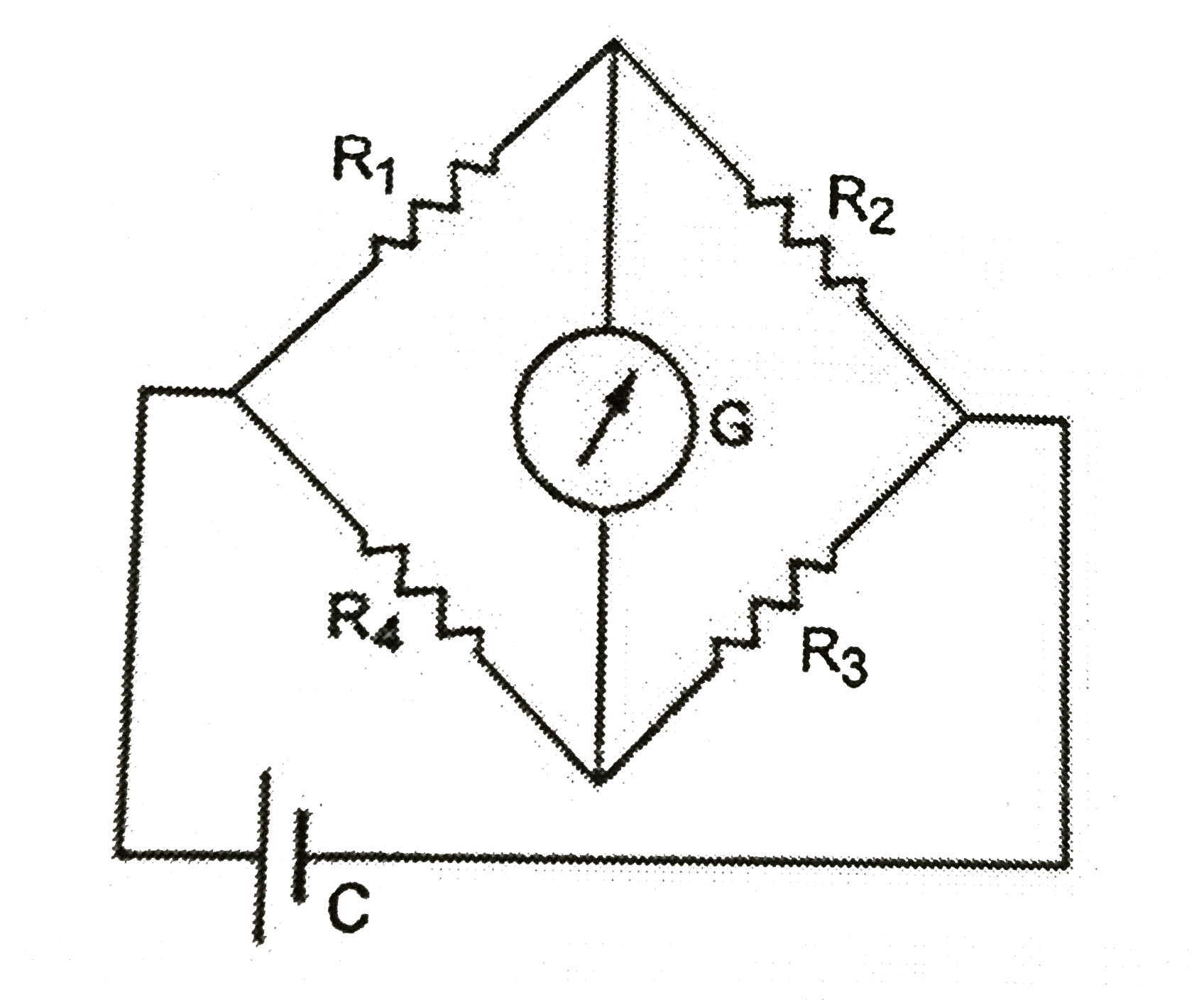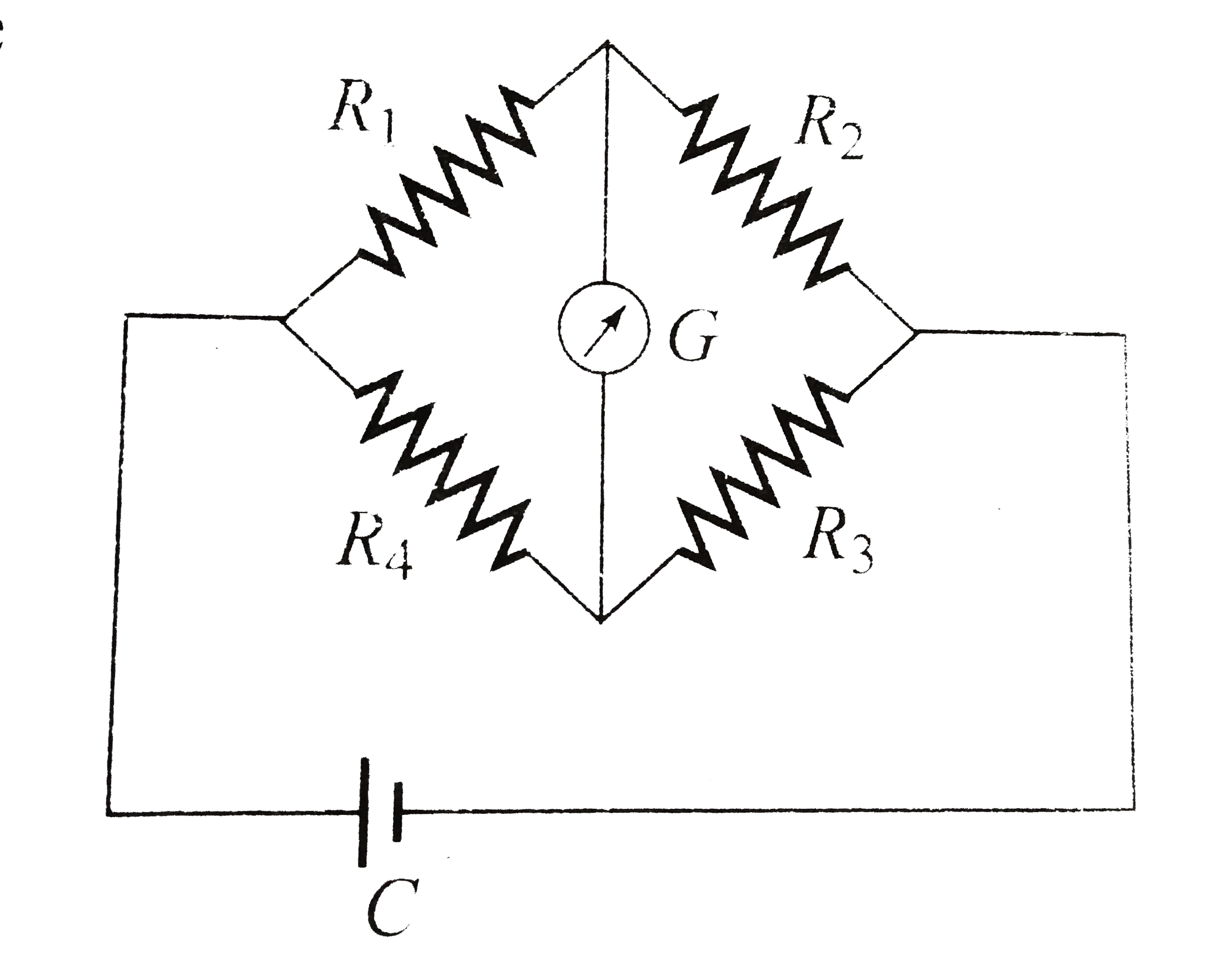A meterbridge is in balance condition. Now if galvanometer and cell are interchanged, the galvanometer shows no deflection. Give reason.
To understand why the galvanometer shows no deflection when the galvanometer and the cell are interchanged in a meter bridge that is already in a balanced condition, let's break down the explanation step by step.
1. Understanding the Meter Bridge Setup:
- A meter bridge consists of a wire of uniform resistance arranged in a bridge configuration with two gaps where resistors can be connected.
- The galvanometer is connected between two points (let's say C and D), and a cell (battery) is connected between the other two points (A and B).
2. Balanced Condition:
- The meter bridge is said to be in a balanced condition when the ratio of the resistances on either side of the galvanometer is equal. Mathematically, this is expressed as:
PQ=RS
- Here, P, Q, R, and S are the resistances connected in the meter bridge.
3. Interchanging the Galvanometer and Cell:
- When the galvanometer and the cell are interchanged, the galvanometer is now connected between points A and B, and the cell is connected between points C and D.
4. Analyzing the New Configuration:
- In the new configuration, the galvanometer is still connected across the same total resistance of the bridge, just at different points.
- The balance condition remains the same because the resistances P, Q, R, and S have not changed; they are still in the same ratio.
5. No Deflection in the Galvanometer:
- Since the meter bridge was initially balanced, and the ratio of resistances has not changed with the interchange, the potential difference across the galvanometer remains zero.
- This means that there is no current flowing through the galvanometer, which results in no deflection.
6. Conclusion:
- Therefore, the reason the galvanometer shows no deflection after interchanging it with the cell is that the balance condition of the meter bridge remains unchanged, leading to zero potential difference across the galvanometer.
- A meter bridge consists of a wire of uniform resistance arranged in a bridge configuration with two gaps where resistors can be connected.
- The galvanometer is connected between two points (let's say C and D), and a cell (battery) is connected between the other two points (A and B).
- The meter bridge is said to be in a balanced condition when the ratio of the resistances on either side of the galvanometer is equal. Mathematically, this is expressed as:
PQ=RS
- Here, P, Q, R, and S are the resistances connected in the meter bridge.
- When the galvanometer and the cell are interchanged, the galvanometer is now connected between points A and B, and the cell is connected between points C and D.
- In the new configuration, the galvanometer is still connected across the same total resistance of the bridge, just at different points.
- The balance condition remains the same because the resistances P, Q, R, and S have not changed; they are still in the same ratio.
- Since the meter bridge was initially balanced, and the ratio of resistances has not changed with the interchange, the potential difference across the galvanometer remains zero.
- This means that there is no current flowing through the galvanometer, which results in no deflection.
- Therefore, the reason the galvanometer shows no deflection after interchanging it with the cell is that the balance condition of the meter bridge remains unchanged, leading to zero potential difference across the galvanometer.
Topper's Solved these Questions
- ELECTROSTATICS AND CURRENT ELECTRICITY BOOK - CBSE COMPLEMENTARY MATERIALCHAPTER - ELECTROSTATICS AND CURRENT ELECTRICITY EXERCISE - SHORT ANSWER QUESTIONS (3 MARKS )
23 Videos
- ELECTROSTATICS AND CURRENT ELECTRICITY BOOK - CBSE COMPLEMENTARY MATERIALCHAPTER - ELECTROSTATICS AND CURRENT ELECTRICITY EXERCISE - LONG ANSWER QUESTIONS
6 Videos
- ELECTROSTATICS AND CURRENT ELECTRICITY BOOK - CBSE COMPLEMENTARY MATERIALCHAPTER - ELECTROSTATICS AND CURRENT ELECTRICITY EXERCISE - NUMERICALS
49 Videos
- ELECTRONIC DEVICES BOOK - CBSE COMPLEMENTARY MATERIALCHAPTER - ELECTRONIC DEVICES EXERCISE - NUMERICALS
7 Videos
- SAMPLE QUESTION PAPER 2019BOOK - CBSE COMPLEMENTARY MATERIALCHAPTER - SAMPLE QUESTION PAPER 2019EXERCISE - Section C
19 Videos
Similar Questions
In potentiometer experiment, when the galvanometer shows no deflection, then no current flows in
View Solution(i) In a metre bridge, the balance point is found to be at 39.5 cm from the end A, when the resistor Y is of 12.5Ω. Determine the resistance of X. Made of thick copper strips?
(ii). Determine the balance point of the bridge above if X and Y are interchanged.
(iii). what happens if the galvanometer and cell are interchanged at the balance point of the bridge ? Would the galvanometer show any current?
View Solution
Knowledge Check
If galvanometer and battery are interchanged in balanced wheatstone bridge, then
Athe battery dischargesBthe bridges still balancesCthe balance point is changedDthe galvanometer is damaged due to flow of high current.If the battery and galvanometer are interchanged then the deflection in galvanometer will
ASee no changeBChange in previous directionCChange in opposite directionDCircuit will dieIn a wheatstone bridge if the battery and galvanometer are interchanged then the deflection in galvanometer will
Achange in previous directionBnot changeCchange in opposite directionDnone of these.
In the figure, galvanometer G gives maximum deflection when

View Solution
The Wheatstone bridge shown in the above figure is balanced. If the positions of the cell C and the galvanometer G are now interchanged, G will show zero deflection
View SolutionFigure (a) below shows a wheat stone bridge in which P, Q, R, S are fixed resistances, G is a galvanometer and B is a battery. For this particular case the galvanometer shows zero deflection. Now, only the positions of B and G are interchanged, as shown in figure (b). The new deflection of the galvanometer -
 s
s
View SolutionThe Wheatstone's bridge shown in the Fig. A2.5 is balanced. If the positions of the cell C and the galvanometer F are now interchanged, G will show zero deflection

View SolutionIn a ballistic galvanometer the deflection is proportional to
View Solution